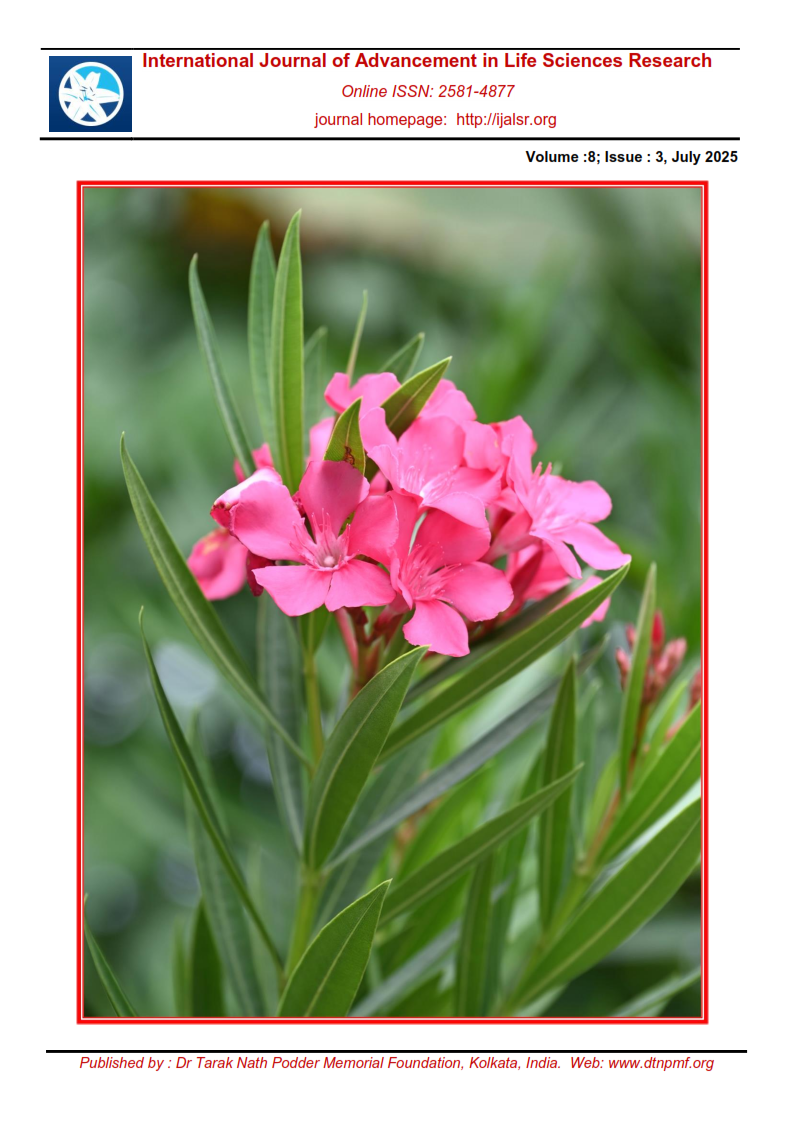Enhancing Ezetimibe Absorption: Formation and Characterization of Drug Cocrystals with Carboxylic Acid Coformers
Abstract
Background: Ezetimibe (EZT) is a newer FDA-approved drug that inhibits cholesterol absorption in the intestines without affecting the uptake of fat-soluble vitamins. However, EZT is classified under the Biopharmaceutics Classification System (BCS) as a Class II drug, characterised by low solubility and limited absorption. Objective: This study aims to enhance the solubility and bioavailability of EZT through cocrystallisation with carboxylic acid coformers. Methods: Cocrystals were prepared using the solvent-drop grinding technique. Characterisation was performed using Particle Size Analysis (PSA), Powder X-ray Diffraction (PXRD), Differential Scanning Calorimetry (DSC), Fourier Transform Infrared Spectroscopy (FTIR), Scanning Electron Microscopy (SEM), and dissolution testing. Results: The EZT cocrystals exhibited a smaller particle size (0.728 µm) compared to pure EZT (1.049 µm), and PXRD analysis confirmed the formation of a new crystalline phase. DSC results showed a reduced melting point for the cocrystal (76.99°C) compared to pure EZT (81.54°C), while FTIR spectra indicated the formation of hydrogen bonds. SEM images revealed that the cocrystals had a more fragmented and rougher morphology compared to the smoother particles of pure EZT. Dissolution testing demonstrated enhanced solubility, with 49.13% of the EZT cocrystal dissolved at 15 minutes versus 13.90% for pure EZT, indicating improved potential for absorption and therapeutic efficacy. Conclusion: The formation of EZT cocrystals significantly enhances the drug’s solubility and absorption, supporting the potential of cocrystallisation as an effective strategy for improving the bioavailability of poorly soluble drugs.
Downloads
References
Ancheria, R. K., Jain, S., Kumar, D., Soni, S. L., & Sharma, M. (2019). An overview of pharmaceutical co-crystal. Asian Journal of Pharmaceutical Research and Development, 7(2), 39-46.https://doi.org/10.22270/ajprd.v7i2.483
Aris, P., Mohamadzadeh, M., Zarei, M., & Xia, X. (2024). Computational Design of Novel Griseofulvin Derivatives Demonstrating Potential Antibacterial Activity: Insights from Molecular Docking and Molecular Dynamics Simulation. International Journal of Mlecular Sciences, 25(2), 1039.https://doi.org/10.3390/ijms25021039
Asati, A. V., Salunkhe, K. S., Singh Rajput, R. P., Chintamani, S. R., Khairnar, A. U., Patil, N. S., & Chintamani, R. N. (2023). Co-Crystals: a novel approach to improve the solubility of apixaban. International Journal of Pharmaceutical Investigation, 13(2), 243-247. Available at: https://jpionline.org/storage/2023/05/IntJPharmInvestigation-13-2-243.pdf
D’Abbrunzo, I., Procida, G., & Perissutti, B. (2023). Praziquantel fifty years on: A comprehensive overview of its solid state. Pharmaceutics, 16(1). https://doi.org/10.3390/pharmaceutics16010027
Ding, P., Liu, Z., Wu, Y., Zong, C., Wang, Y., Xu, Y., ... & Wang, L. (2025). Preparation, structure characterization and solubility of one cocrystal and one salt of Imatinib with Citric acid and Fumaric acid. Journal of Molecular Structure,1333, 141769. https://ui.adsabs.harvard.edu/link_gateway/2025JMoSt133341769D/doi:10.1016/j.molstruc.2025.141769
Dyba, A. J., Wiacek, E., Nowak, M., Janczak, J., Nartowski, K. P., & Braun, D. E. (2023). Metronidazole cocrystal polymorphs with gallic and gentisic acid accessed through slurry, atomization techniques, and thermal methods. Crystal Growth & Design, 23(11), 8241-8260.https://doi.org/10.1021/acs.cgd.3c00951
Ferdiansyah, R., Ardiansyah, S. A., Rachmaniar, R., & Yuniar, I. (2021). Pengaruh pembentukan kokristal menggunakan koformer asam karboksilat dengan metode solvent evaporation dan solvent drop grinding terhadap bioavailabilitas zat aktif. [The effect of cocrystal formation using carboxylic acid coformer with solvent evaporation and solvent drop grinding methods on the bioavailability of active substances.] Jurnal Ilmiah Farmako Bahari, 12(1), 28-38.https://doi.org/10.52434/jfb.v12i1.987
Jia, Z., Li, J., Gao, L., Yang, D., & Kanaev, A. (2023). Dynamic light scattering: a powerful tool for in situ nanoparticle sizing. Colloids and Interfaces, 7(1), 15.https://doi.org/10.3390/colloids7010015
Karthammaiah, G. N., Venkataramanan, N. S., & Solomon, K. A. (2025). Synthesis, characterization, computational studies and biological activity of gallic acid-picolinic acid cocrystal salt hydrate. Journal of Molecular Structure, 1336, 142056.https://doi.org/10.1016/j.molstruc.2025.142056
Li, C., Zhang, C., Yan, Y., Liang, W., Xu, J., & Chen, W. (2023). Multicomponent crystals of clozapine with improved solubility: a combined theoretical and experimental strategy on coformer screening and structure–property. Crystal Growth & Design, 23(10), 7295-7315.https://doi.org/10.1021/acs.cgd.3c00683
Nechipadappu, S. K., & Balasubramanian, S. (2023). Solid-state versatility in tranexamic acid drug: structural and thermal behavior of new salts and cocrystals. Structural Science, 79(1), 78-97.http://dx.doi.org/10.1107/S2052520622011969
Purwanto, A., Muthaharah, M., & Andika, A. (2024). Peningkatan kelarutan dan laju disolusi gliklazid dengan polimer Silika Mikrosfer (Sm).[Enhancement of solubility and dissolution rate of gliclazide with Silica Microsphere (SM) polymer] Jurnal Ilmiah Farmako Bahari, 15(1), 49-60.https://journal.uniga.ac.id/index.php/JFB/article/view/3109
Singh, M., Barua, H., Jyothi, V. G. S., Dhondale, M. R., Nambiar, A. G., Agrawal, A. K., ... & Kumar, D. (2023). Cocrystals by design: A rational coformer selection approach for tackling the API problems. Pharmaceutics, 15(4),1161.https://doi.org/10.3390/pharmaceutics15041161
Torquetti, C., Ferreira, P. O., de Almeida, A. C., Fernandes, R. P., & Caires, F. J. (2022). Thermal study and characterization of new cocrystals of ciprofloxacin with picolinic acid. Journal of Thermal Analysis and Calorimetry, 147(2), 1299-1306. http://dx.doi.org/10.1007/s10973-020-10479-3
Xiong, J., Xu, D., Zhang, H., Shi, Y., Wu, X., & Wang, S. (2024). Improving the Solubility and Bioavailability of Progesterone Cocrystals with Selected Carboxylic Acids. Pharmaceutics, 16(6), 816. https://doi.org/10.3390/pharmaceutics16060816
Yang, S., Liu, Q., Ji, W., An, Q., Song, J., Xing, C., ... & Du, G. (2022). Cocrystals of praziquantel with phenolic acids: discovery, characterization, and evaluation. Molecules, 27(6), 2022.https://doi.org/10.3390/molecules27062022
Zhou, J., Li, L., Zhang, H., Xu, J., Huang, D., Gong, N., ... & Zhou, Z. (2020). Crystal structures, dissolution and pharmacokinetic study on a novel phosphodiesterase-4 inhibitor chlorbipram cocrystals. International Journal of Pharmaceutics, 576, 118984.https://doi.org/10.1016/j.ijpharm.2019.118984

This work is licensed under a Creative Commons Attribution-NonCommercial 4.0 International License.


















 .
.